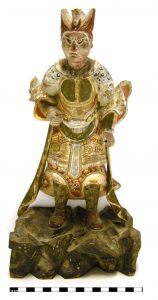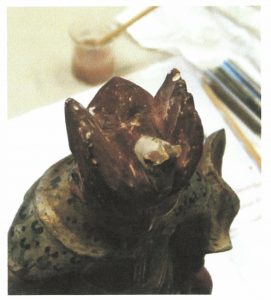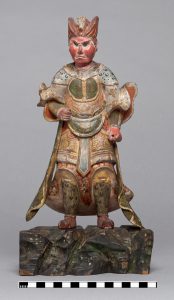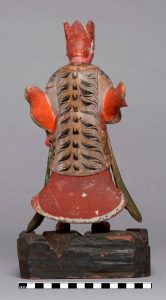September ’19
Polychrome Figurine

September’s Object of the Month is a polychrome sculpture of a Juni Shinshō from the Oriental Museum collections.
The museum accession record describes the figure as being Chinese or south-east Asian and representing one of the Four Heavenly Kings from the Buddhist pantheon. However the iconography favours more of a Japanese design. The animals on the headdress indicates that the figure represents one of the co-called Twelve Divine Generals or Juno Shinshō.

The Juni Shinshō were among the very first Buddhist deities to be introduced into Japan, arriving from Korea and China in the 6th and 7th century AD. The Juni Shinshō also belong to the Tenbu; a larger grouping of protective Buddhist deities and are individually referred to as Taisho (Great General). Typically they are depicted wearing armour, they have a helmet or spiked hair and are usually stood in a threatening or martial stance with a ferocious facial expression.

They became associated in Japan with the twelve animals of the zodiac by the late Heian (AD 794-1185) or early Kamakura era (AD 1185-1333) after which the sculptures started to show animals on the headdresses. The names of the generals seem to alter depending on the tradition; this figure could represent Indara Taisho or Sanchira Taisho. From research into the various depictions of the Generals, it is possible that Buddhist iconographical collections would suggest this figure is more likely to be Sanchira Taisho as this was the deity corresponding to the sign of the horse.

The bright colour palette, style and manufacture of the figurine suggest a date in the Edo period (1603-1868) when Japan was ruled by the Shoguns of the Tokugawa family. It is difficult to further refine the date range, but facial features and the three pointed headdress bear similarities to a 19th century Japanese carved wood figure of Zao Gongen. The robe carving, and the painted and gilded floral borders also resemble polychrome wooden figurines from the 18th century.
Conservation

Initial surface cleaning was completed using dry cleaning methods. A number of different options were tested and the decision was made to use a conservation specific product known as smokesponge to carefully remove surface dust and dirt. Wet cleaning was not considered due to the fact that the majority of the pigments were susceptible to solvents.

Dry cleaning however did not remove all of the dirt and encrustations on the surface of the figuring and so mechanical cleaning was tested to see whether the white calcium based encrustations could be removed from the gilded areas and face. Mechanical cleaning proved successful, though only the areas that were easy to access had the white encrustations removed. Any evidence of encrustations in deep recesses were left to avoid potentially damaging the pigment.

An area of excess adhesive found on the back of the neck and cloak was removed as it was slightly disfiguring. Mechanical removal was preferable as this would reduce the risk of damage to the paint.

Although the majority of the figure was stable, there were a few areas of noticeable cracking and it was decided that these areas would be filled in order to help stabilize the figure and prevent further deterioration. An appropriate fill material was chosen which would react to the environment in a similar manner to the polychrome figure. This was applied carefully using the end of a cocktail stick; drops of water were then applied along the crack in order to ensure a smooth finish to the fill material as it dried. Once the fill material had cured, the material was colour matched using water colour pigments in order to blend with the original material.


Although the pigments had proved to be susceptible to most solvents, the decision was made to consolidate those areas that were flaking and lifting. Although it was likely the consolidant couldn’t be removed without damaging the paint, if no consolidant was applied it was possible the paint would flake off causing more damage overall. As a result a number of suitable consolidants were tested and the most appropriate one used on the polychrome figure.
Stay tuned for next month’s object!
